THIRD QUARTER MECTIZAN® TREATMENTS REACH 84% OF THE 1998 ANNUAL TREATMENT OBJECTIVE ELIGIBLE AT RISK POPULATION
From January to August 1998, Global 2000 River Blindness Program (GRBP)-assisted programs in the Americas, Cameroon, Nigeria, Sudan, and Uganda used ivermectin(Mectizan®, Merck & Co) to treat 4,900,321 persons. This represents 84% of the GRBP 1998 annual treatment objective for the eligible at risk population (ATOearp) (Table 1). Treatment and health education activites have occurred in 11,938 at risk villages, 74%of the 1998 objective.
Treatments in GRBP-assisted programs since 1996 are shown in Figure 1. The most GRBP-assisted treatments were provided in Nigeria; 3,781,517 (77%) treatments have been provided in 1998. More than 13.8 million treatments have been delivered cumulatively by GRBP-assisted onchocerciasis programs since 1996.
The Lions Clubs and the Lions Club Sight First Program (LCIF) are major partners with GRBP in Nigeria, Cameroon and Sudan. So far in 1998, 3,428,917 GRBP-assisted treatments (60% of all GRBP-assisted treatments) have been in partnership with Lions.
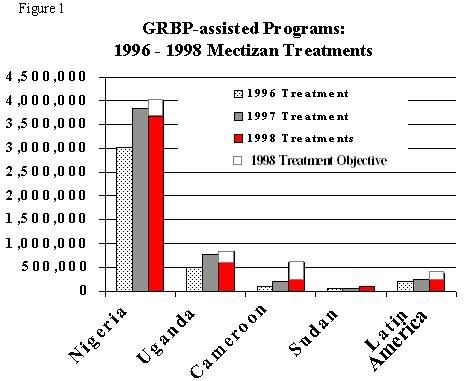
CAMEROON:
Treatments:
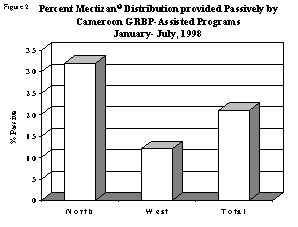 The GRBP-assisted program in Cameroon has reported 236,108 Mectizan treatments so far in 1998. Sixty-one percent of GRBP-assisted treatments this year(142,994) have been provided in West Province, where the Delegate for Health,Dr. Amadou Fopa, has been personally engaged in a health education campaign throughout the province. Still, the 1998 ATOearp for West Province (470,039)remains elusive, with only 30% of that goal reached by July. In North Province,93,114 treatments were provided in 94% of at risk villages, with a coverage of 72% of the eligible at risk populations there.
The GRBP-assisted program in Cameroon has reported 236,108 Mectizan treatments so far in 1998. Sixty-one percent of GRBP-assisted treatments this year(142,994) have been provided in West Province, where the Delegate for Health,Dr. Amadou Fopa, has been personally engaged in a health education campaign throughout the province. Still, the 1998 ATOearp for West Province (470,039)remains elusive, with only 30% of that goal reached by July. In North Province,93,114 treatments were provided in 94% of at risk villages, with a coverage of 72% of the eligible at risk populations there.
Passive treatments(ie, distribution of Mectizan through clinics/dispensaries and hospitals rather than in mass community-based programs) have been reported to represent 20% of all GRBP-assisted treatments in Cameroon. Passive treatments in West province make up 12 % of the total, while in the North Province, 33%of treatments are provided through the passive system.
West Province:Launching of the Third Phase of the Lions Sight First Project
The launching of the 3rd phase of Lions Sight First project in the West Province of Cameroon took place on October 17, 1998, representing the final phase of the project. Present at the ceremony were the Governor of West Province His Excellency Hamadou Tidjani; Dr. Marcelline Ntep, national coordinator of onchocercisis for the Ministry of Public Health; Madame Dominique Coste,President of the Lions Club coalition; and representatives of the four international nongovernmental development organizations (NGDOs) in the LCIF coalition (Sight Savers International, Helen Keller International,International Eye Foundation, and Global 2000/The Carter Center).
The expanded treatmentareas are to include the health districts of Dschang, Santchou, and Mifi.Rapid Epidemiological Assessment was completed earlier this year and revealed primarily hyper- and meso- endemic communities in Santchou and Mifi Districts.Training of Community-Based Distributors was completed in September,and mass treatments will begin immediately,except in the Dschang health district where the predominantly hypo-endemic communities will be treated passively.
Personnel Changes
A number of changes have been made in the Lions/NGDO coalition office. Dr. Rosa Befidi is the new Sight Savers International representative in Cameroon, replacing Dr.Joseph Oye, who will begin a residency in ophthalmology. Mr. Hamdkhan Abdullakhan will be the interim HKI Country Representative, replacing Mr. Tiburce Nyiama.Mrs. Marie Pascaline Menono, previous representative of International Eye Foundation has left. Her replacement is yet to be named.
At the Ministry of Public Health, Dr. Kollo Basile has been appointed National Director of Community Health, replacing Dr. Rene Owona. Dr. Jean Kamso, the Chief of Community Health in West Province will leave to pursue further public health studies in France. We are deeply saddened by the news of the recent death of Dr. Pierre Ngoumou, former National Coordinator of onchocerciasis.Dr. Ngoumou played a key role in the development of Rapid Epidemiological Mapping of Onchocerciasis (REMO) used by APOC.
NIGERIA: 94%of ATO reached!
Treatments
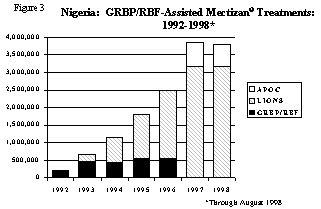 Through August 1998, GRBP Nigeria has helped provide Mectizan® and health education to 3,781,517 eligible at risk persons in 8,539 at risk villages. This treatment figure represents 94% of GRBP Nigeria's ATO (Table1). Figure 3 shows the partnership of GRBP/River Blindness Foundation(RBF)-assisted treatments in Nigeria since 1992. In 1998, 84% of GRBP-assisted treatments have been accomplished with LCIF-support, with the remainder now in partnership with the Africa Program for Onchocerciasis Control (APOC).
Through August 1998, GRBP Nigeria has helped provide Mectizan® and health education to 3,781,517 eligible at risk persons in 8,539 at risk villages. This treatment figure represents 94% of GRBP Nigeria's ATO (Table1). Figure 3 shows the partnership of GRBP/River Blindness Foundation(RBF)-assisted treatments in Nigeria since 1992. In 1998, 84% of GRBP-assisted treatments have been accomplished with LCIF-support, with the remainder now in partnership with the Africa Program for Onchocerciasis Control (APOC).
Meetings
The most recent Nigerian NGDO meeting chaired by Dr. Elizabeth O. Elhassan of Sight Savers International, was held on October 13, 1998. That meeting was immediately followed by the National Onchocerciasis Task Force (NOTF) meeting, chaired by Dr. Jonathan Jiya, Federal Ministry of Health. Both gatherings were held in Maiduguri, Borno State, and were attended by officials from the various NGDOs, Zonal and State offices, the World Health Organization,and UNICEF. It was reported that 7.6 million persons have been treated in Nigeria so far in 1998, 63% of the 12 million 1998 annual treatment objective. The next meetings will be held 21-22 April.
National Oncho Dayon February 12, 1999 will be celebrated with ministerial press conference and a scientific symposium in Abuja.
A Sustainable Management Training Center (SMTC) reunion was held at the Global 2000 headquarters in Jos, from October 5-9. During the reunion recent graduates gave presentations of total quality management (TQM) solutions to management problems they identified during the course. The next basic management training workshop will be held October 20-30 at the SMTC. Two staff members from the Lassa Fever Research Project/CDC in Kindia, Republic of Guinea, will attend.
Dr. ES Miri, Nigeria country representative of Global 2000, attended a meeting in Lagos, Nigeria,to finalize the new national plan for lymphatic filariasis elimination from Nigeria. The meeting was chaired by Dr. MY Jinadu, national coordinator for both lymphatic filariasis elimination and schistosomiasis control programs.
SUDAN: 1998 Mectizan®treatments have already surpassed 1997 figure
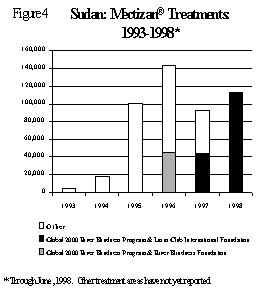 From January to June 1998, 113,242 persons have received treatment with Mectizan® in Sudan with LCIF/GRBP support (Table 1).Despite difficult conditions due to famine and continued fighting in 1998,persons treated in Sudan through June have actually surpassed the total number treated in 1997 by 20,104 (22%) (Figure 4). Most of these treatments(96,366, or 90%) were carried out by the Government of Sudan. Due to a lag in reporting, more persons have been treated by the Southern Sudan Onchocerciasis Control Program (operating under Operation Lifeline Sudan/UNICEFand coordinated by Health Net) than reported here. Since the LCIF/GRBP project began in 1997, a total of 160,381 treatments have been administered.
From January to June 1998, 113,242 persons have received treatment with Mectizan® in Sudan with LCIF/GRBP support (Table 1).Despite difficult conditions due to famine and continued fighting in 1998,persons treated in Sudan through June have actually surpassed the total number treated in 1997 by 20,104 (22%) (Figure 4). Most of these treatments(96,366, or 90%) were carried out by the Government of Sudan. Due to a lag in reporting, more persons have been treated by the Southern Sudan Onchocerciasis Control Program (operating under Operation Lifeline Sudan/UNICEFand coordinated by Health Net) than reported here. Since the LCIF/GRBP project began in 1997, a total of 160,381 treatments have been administered.
Nevertheless, the fighting in Wau and Bahr El Ghazal has hampered treatment activities, and some onchocerciasis workers were killed, while others fled. Famine condition sexist in many areas of southern Sudan, with Bahr El Ghazal the worst affected.The World Food Program (WFP) estimates that about 2.5 million people are at risk of being under nourished (the estimated population of southern Sudan is 4-5 million).
UGANDA:
Through August 1998,GRBP Uganda has helped provide Mectizan® to 581,486 eligible at risk persons in 1,355 at risk villages. This treatment figure represents 69%of GRBP Uganda's 1998 ATOearp (Table 1).
An evaluation of APOC Phase 1 activities by independent scientists took place from 14 September- 3 October in the districts of Kisoro, Hoima, and Masindi. Unfortunately,the team was unable to visit Kasese due to insecurity (Kasese represents80% of GRBP/APOC Phase 1 treatment area). The 12-member team, which focused on the implementation of Community Directed Treatment with Ivermectin (CDTI),included three Nigerians (Dr. Dan Obikenze, Dr. Bamikale Feyisetan, Dr.Oka Obono), and an American (Dr. William Brieger). Among its many conclusions,the group noted the need for district health departments to increase their financial commitments to the APOC-supported programs.
Mr. Dominic Mutabazi attended a WHO/TDR workshop in Awka, Nigeria from September 5-8. Other participants were from Mali, Togo, Ghana, and Nigeria. The objective of the workshop was to pre-test the research instruments for the phase 2 multi-country study on CDTI and sustainability. These studies are sponsored by the WHO Tropical Disease Research (TDR) program.
Latin America:
Treatments
The Onchocerciasis Elimination Program for the Americas (OEPA) is a regional coalition working to eliminate morbidity, and where possible,transmission of onchocerciasis in the Americas through sustained distribution of Mectizan. Semiannual treatment (e.g., every six months) is advocated wherever possible. The six endemic countries are Brazil, Colombia, Ecuador,Guatemala, Mexico, and Venezuela. GRBP coordinates the technical and financial assistance to the initiative through the OEPA office in Guatemala. The InterAmerican Development Bank and CDC are major partners with Pan American Health Organization (PAHO) and The Carter Center in the initiative.
For the American Region as a whole, 187,968 treatments have been reported through June, compared with 152,486 persons treated in the same intervalin 1997, an increase of 23%. So far 75% of the 252 known hyperendemic communitiesin the Americas have received at least one Mectizan treatment round in1998 (95% were reached in 1997).
Venezuela
Venezuela represents the greatest challenge to the American initiative.It is estimated that 2,500 additional communities are yet to be assessed for need for Mectizan distribution; many of which are likely to be hyperendemic and in urgent need of Mectizan® treatment. The areas to be assessed are in the north of the country (particularly the states of Sucre, Monagas,and Aragua). Dr. Carlos Gonzales, OEPA consultant epidemiologist, has been working primarily in Sucre State with Dr. Harlan Schuler, national coordinator for onchocerciasis, ministry of health, to assess an estimated 400 communities there.
Representatives of the six endemic American countries have met annually since 1991 at the InterAmerican conferences on Onchocerciasis (IACOs).The eighth conference (IACO '98) will be held in Caracas on 17-19 November,and has a theme of "Sustainability of Mectizan Treatment." Dr. Uche Amazigo,social scientist, APOC, will present the CDTI strategy for community participation in Africa. Additional focus will be given to integration of the distribution program into the primary health care system and importation of the drug into the countries (an increasing problem in several Latin American countries).An update on the assessment activities in northern Venezuela will also be presented.
OTHER NEWS:
Dr. Frank Richards, technical director, GRBP, participated in meetings in Haywards Heath, England in July, of the international coalition of NGDOs involved in ivermectin distribution. In August he attended the meetings of the Technical Consultative Committee (TCC) of APOC.
Under the auspices of the Federal Ministry of Health, a combined meeting of the Nigerian national guinea worm eradication program, the nationallyjphatic filariasis elimination program, the national schistosomiasis control program, and the Nigeria GRBP will take place in Abuja, Nigeria,October 28-30.
The third annual GRBP program review will be held at The Carter Center in Atlanta, GA USA on February 23-25, 1999.
Selected References
Boussinesq M. L'onchocercose humaine en Afrique.(Humanonchocercias is in Africa). Med Trop. March 1997; 57 (4) p389-400.
Mutabazi D; Duke BO. Global 2000 River Blindness Programme,Kampala, Uganda.. Ann Trop Med Parasitol Mar 1998, 92 (2) p195-203.
Thylefors B. Programme for the Prevention of Blindness and Deafness. World Health Forum. 1998, 19 (1) p53-9.
Molyneux DH. Patterns of change in vector-borne diseases.Ann Trop Med Parasitol. Oct 1997, 91 (7) p827-39
Gaxotte P. L'onchocercose et le programme de donation Mectizan. (Onchocerciasis and the Mectizan donation program). SanteJan-Feb 1998, 8 (1) p9-11.
Diarra T. La distribution et le traitement par l'ivermectinesous directives communautaires. (Distribution and treatment using ivermectinunder community directives) Sante Jan-Feb 1998, 8 (1) p81-3.
Dix annees de mectizan en Afrique: des partenariats pourun succes prolonge. Congres de Bamako, Mali, 4-5 novembre 1997. ([Ten Years of Mectizan in Africa: Partnerships for Long-Term Success. Conference proceedings.Mali, November 4-5, 1997) Sante Jan-Feb 1998, 8 (1) p8-88.
Mohamed S; Dormant A; Nyiama T; Kassalow J; Laursen K;Baker SK; Boubacar IC. Le role d'une strategie information, education etcommunication dans les programmes de traitement par ivermectine (Mectizan)sous directives communautaires.(The strategic role of information, education and communication in treatment programs using ivermectin (Mectizan) under community directives) Sante Jan-Feb 1998, 8 (1) p79-80.
Meftuh AB. Amelioration de la qualite de vie en Afriquerurale (AFRICARE) face a l'onchocercose au Tchad (programme de la donationMectizan). (Improvement in the quality of life in rural Africa (AFRICARE)in the face of onchocerciasis in Chad (Mectizan donation program)) SanteJan-Feb 1998, 8 (1) p63.
Namangue K. Programme de lutte contre l'onchocercoseau Tchad: la donation Mectizan. (Onchocerciasis control program in Chad:the Mectizan donation) Sante Jan-Feb 1998, 8 (1)
Philippon B; Seketeli A. Genese de l'OCP et situationde l'onchocercose en Afrique occidentale avant les mesures de controle.(The beginning of the OPC and the status of onchocerciasis in western Africa before control measures) Sante Jan-Feb 1998, 8 (1) p27-31.
Benton B; Dadzie Y; Boatin B. Le programme de luttecontre l'onchocercose en Afrique de l'Ouest (OCP):caracteristiques essentielles.(The onchocerciasis control program in West Africa (OCP): essential characteristics)Sante Jan-Feb 1998, 8 (1) p26.
Ndyomugyenyi R. Onchocerciasis control in Uganda. World Health Forum 1998, 19 (2) p192-5.
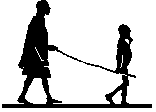

Please sign up below for important news about the work of The Carter Center and special event invitations.